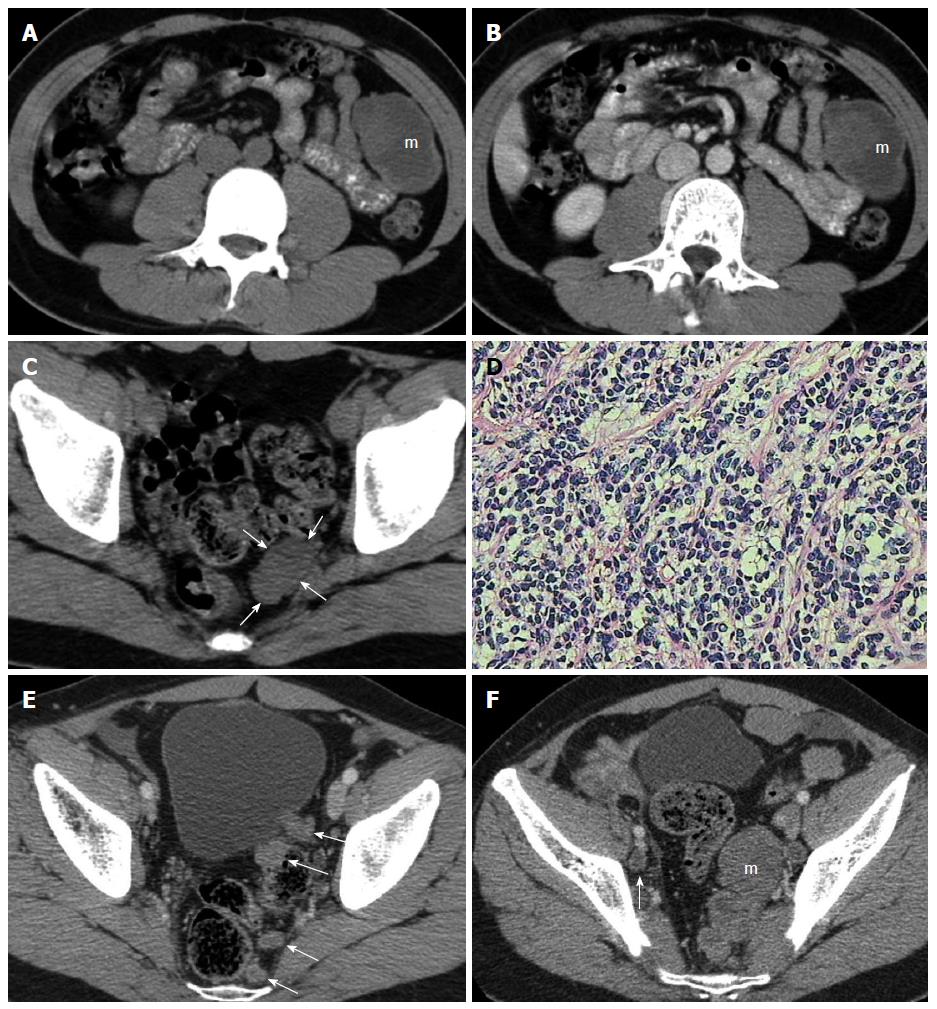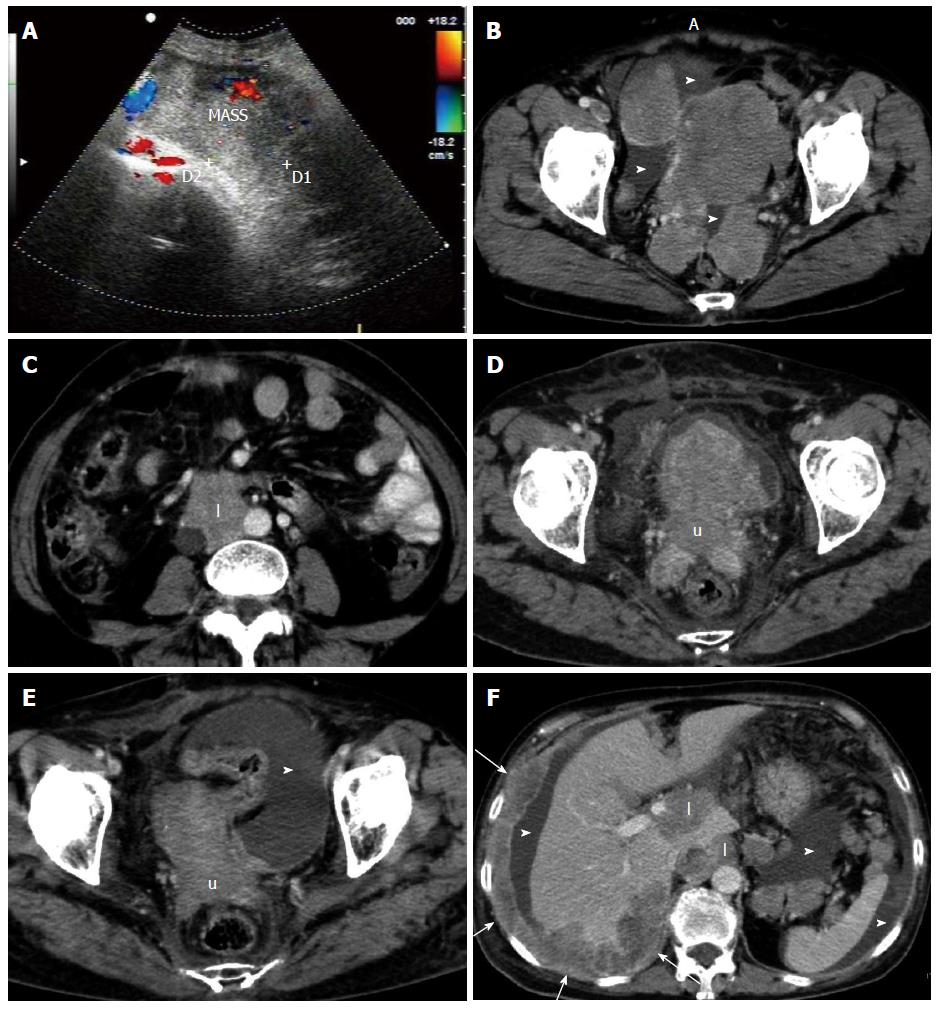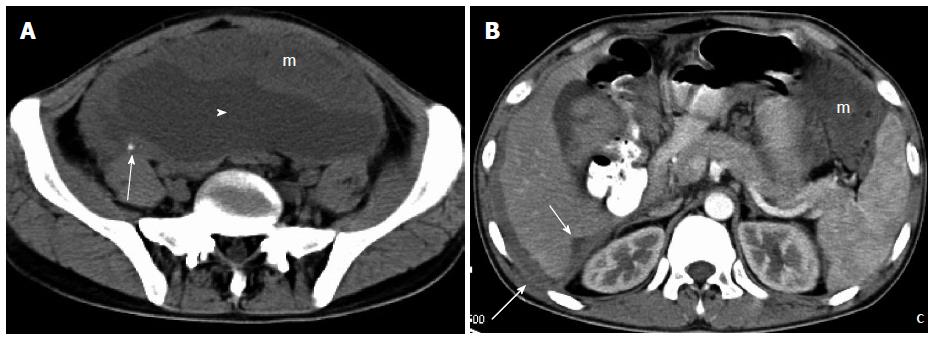Copyright
©2014 Baishideng Publishing Group Co.
World J Gastroenterol. May 7, 2014; 20(17): 5157-5164
Published online May 7, 2014. doi: 10.3748/wjg.v20.i17.5157
Published online May 7, 2014. doi: 10.3748/wjg.v20.i17.5157
Figure 1 A 26-year-old man without any clinical symptoms.
A-C: Preoperative plain and contrast-enhanced computed tomography (CT) showed a solid-cystic mass (m) in the left mid-abdomen and a homogeneous soft-tissue mass (arrows) in the pelvis (A and C: Plain scan, B: Enhanced scan). The solid area of the abdominal tumor showed slight enhancement; D: Photomicrograph of surgical specimen showed nests or clusters of small tumor cells outlined by characteristic desmoplastic stromal bands (hematoxylin and eosin staining, × 400); E: CT re-examination 33 mo after surgery showed multiple homogeneous tumor nodules (arrows) reappearing in the retrovesical and pararectal regions; F: Six months later, CT showed that pelvic tumor nodules had enlarged rapidly forming a multinodular confluent tumor (m), as well as a slightly enlarged lymph node (arrow).
Figure 2 A 28-year-old woman with a large abdominopelvic desmoplastic small round cell tumor.
A: Enhanced computed tomography (CT) 4 mo after surgery showed a bulky heterogeneous pelvic mass with areas of low attenuation, and the solid portion of the mass showed obvious enhancement; B, C: Enhanced CT scan 1 mo later showed well-enhanced, lobulated mesenteric masses (m) in the right lower quadrant. A small amount of peritoneal effusion (arrowhead), enlarged para-aortic lymph node (l), right hydroureter (white arrow), omentum nodules (n), and liver metastases (black arrow) were also present.
Figure 3 A 64-year-old woman with frequent urination and low back pain.
A: Abdominal US demonstrated a large heterogeneous hypoechoic mass with surrounding blood flow; B, C: Contrast-enhanced computed tomography (CT) before treatment showed multiple well-enhanced masses with variable sizes in the pelvic cavity, as well as a small amount of ascites (arrowheads) and lymphadenopathy within the retroperitoneum (l); D: Enhanced CT at the later stage of radiotherapy, showed marked shrinkage of the pelvic tumors (“u” for uterus), along with a small volume of ascites (arrowhead); E, F: Enhanced CT 3 wk after radiotherapy showed further reduced volume of the masses (“u” for uterus). At the same time, diffuse and nodular serous membrane thickening (arrows) with liver infiltration and innumerable mesenteric masses of variable size in the left upper quadrant, and lymphadenopathy (l) within the retroperitoneum and hepatic portal region, along with a moderate volume of ascites (arrowhead), were demonstrated. All of the tumor tissues presented with heterogeneous moderate enhancement.
Figure 4 A 24-year-old man with faint abdominal pain.
A: Plain computed tomography (CT) demonstrated a large, wavy, omental soft-tissue mass (m) with foci of calcification (arrow), and massive ascites (arrowhead); B: Enhanced CT showed diffuse thickening of the perihepatic parietal peritoneum with liver infiltration (arrows), and omental mass (m). All of the tumor tissues presented with slight uniform enhancement.
- Citation: Shen XZ, Zhao JG, Wu JJ, Liu F. Clinical and computed tomography features of adult abdominopelvic desmoplastic small round cell tumor. World J Gastroenterol 2014; 20(17): 5157-5164
- URL: https://www.wjgnet.com/1007-9327/full/v20/i17/5157.htm
- DOI: https://dx.doi.org/10.3748/wjg.v20.i17.5157












